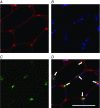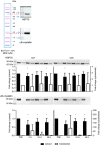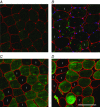The effects of cold water immersion and active recovery on inflammation and cell stress responses in human skeletal muscle after resistance exercise
- PMID: 27704555
- PMCID: PMC5285720
- DOI: 10.1113/JP272881
The effects of cold water immersion and active recovery on inflammation and cell stress responses in human skeletal muscle after resistance exercise
Abstract
Key points: Cold water immersion and active recovery are common post-exercise recovery treatments. A key assumption about the benefits of cold water immersion is that it reduces inflammation in skeletal muscle. However, no data are available from humans to support this notion. We compared the effects of cold water immersion and active recovery on inflammatory and cellular stress responses in skeletal muscle from exercise-trained men 2, 24 and 48 h during recovery after acute resistance exercise. Exercise led to the infiltration of inflammatory cells, with increased mRNA expression of pro-inflammatory cytokines and neurotrophins, and the subcellular translocation of heat shock proteins in muscle. These responses did not differ significantly between cold water immersion and active recovery. Our results suggest that cold water immersion is no more effective than active recovery for minimizing the inflammatory and stress responses in muscle after resistance exercise.
Abstract: Cold water immersion and active recovery are common post-exercise recovery treatments. However, little is known about whether these treatments influence inflammation and cellular stress in human skeletal muscle after exercise. We compared the effects of cold water immersion versus active recovery on inflammatory cells, pro-inflammatory cytokines, neurotrophins and heat shock proteins (HSPs) in skeletal muscle after intense resistance exercise. Nine active men performed unilateral lower-body resistance exercise on separate days, at least 1 week apart. On one day, they immersed their lower body in cold water (10°C) for 10 min after exercise. On the other day, they cycled at a low intensity for 10 min after exercise. Muscle biopsies were collected from the exercised leg before, 2, 24 and 48 h after exercise in both trials. Exercise increased intramuscular neutrophil and macrophage counts, MAC1 and CD163 mRNA expression (P < 0.05). Exercise also increased IL1β, TNF, IL6, CCL2, CCL4, CXCL2, IL8 and LIF mRNA expression (P < 0.05). As evidence of hyperalgesia, the expression of NGF and GDNF mRNA increased after exercise (P < 0.05). The cytosolic protein content of αB-crystallin and HSP70 decreased after exercise (P < 0.05). This response was accompanied by increases in the cytoskeletal protein content of αB-crystallin and the percentage of type II fibres stained for αB-crystallin. Changes in inflammatory cells, cytokines, neurotrophins and HSPs did not differ significantly between the recovery treatments. These findings indicate that cold water immersion is no more effective than active recovery for reducing inflammation or cellular stress in muscle after a bout of resistance exercise.
Keywords: cryotherapy; cytokines; inflammation; macrophages; neutrophils; recovery.
© 2016 The Authors. The Journal of Physiology © 2016 The Physiological Society.
Figures










Comment in
-
Is the ice bath finally melting? Cold water immersion is no greater than active recovery upon local and systemic inflammatory cellular stress in humans.J Physiol. 2017 Mar 15;595(6):1857-1858. doi: 10.1113/JP273796. Epub 2017 Jan 24. J Physiol. 2017. PMID: 27991663 Free PMC article. No abstract available.
-
Post-exercise recovery regimes: blowing hot and cold.J Physiol. 2017 Feb 1;595(3):627-628. doi: 10.1113/JP273503. J Physiol. 2017. PMID: 28145006 Free PMC article. No abstract available.
-
Cold water immersion mechanisms for recovery following exercise: cellular stress and inflammation require closer examination.J Physiol. 2017 Feb 1;595(3):631-632. doi: 10.1113/JP273659. J Physiol. 2017. PMID: 28145015 Free PMC article. No abstract available.
-
Cold water immersion after exercise: recent data and perspectives on "kaumatherapy".J Physiol. 2017 May 1;595(9):2783-2784. doi: 10.1113/JP274169. Epub 2017 Apr 9. J Physiol. 2017. PMID: 28244130 Free PMC article. No abstract available.
-
Cryotherapy: Are we freezing the benefits of exercise?Temperature (Austin). 2017 Mar 28;4(3):211-213. doi: 10.1080/23328940.2017.1304194. eCollection 2017. Temperature (Austin). 2017. PMID: 28944266 Free PMC article. No abstract available.
References
-
- Andersson H, Bohn SK, Raastad T, Paulsen G, Blomhoff R & Kadi F (2010). Differences in the inflammatory plasma cytokine response following two elite female soccer games separated by a 72‐h recovery. Scand J Med Sci Sports 20, 740–747. - PubMed
-
- Bangsbo J, Graham T, Johansen L & Saltin B (1994). Muscle lactate metabolism in recovery from intense exhaustive exercise: impact of light exercise. J Appl Physiol 77, 1890–1895. - PubMed
-
- Bleakley C, Glasgow P, Phillips N, Hanna L, Callaghan M, Davison G, Hopkins T & Delahunt E (2010). Management of Acute Soft Tissue Injury Using Protection Rest Ice Compression and Elevation: Recommendations from the Association of Chartered Physiotherapists in Sports and Exercise Medicine (ACPSM) Association of Chartered Physiotherapists in Sports and Exercise Medicine, Sheffield. http://www.physiosinsport.org/media/wysiwyg/ACPSM_Physio_Price_A4.pdf.
-
- Broussard SR, McCusker RH, Novakofski JE, Strle K, Shen WH, Johnson RW, Dantzer R & Kelley KW (2004). IL‐1β impairs insulin‐like growth factor I‐induced differentiation and downstream activation signals of the insulin‐like growth factor I receptor in myoblasts. J Immunol 172, 7713–7720. - PubMed
Publication types
MeSH terms
Substances
LinkOut - more resources
Full Text Sources
Other Literature Sources
Medical
Research Materials

